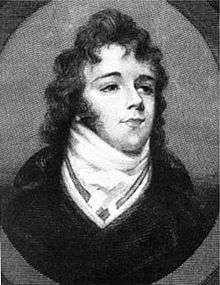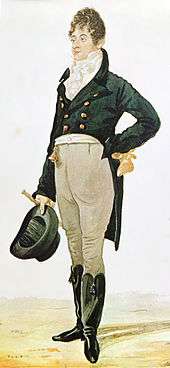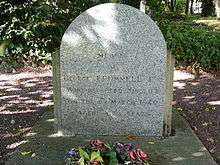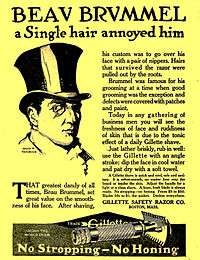Beau Brummell
| Beau Brummell | |
|---|---|
 Brummell, engraved from a miniature portrait | |
| Born |
George Bryan Brummell 7 June 1778 London, Great Britain |
| Died |
30 March 1840 (aged 59) Le Bon Sauveur Asylum, Caen, France |
| Nationality | British |
| Education | Eton College |
| Alma mater | Oriel College, Oxford |
George Bryan "Beau" Brummell (7 June 1778 – 30 March 1840) was an iconic figure in Regency England, the arbiter of men's fashion, and a friend of the Prince Regent, the future King George IV. He established the mode of dress for men that rejected overly ornate fashions for one of understated, but perfectly fitted and tailored bespoke garments. This look was based on dark coats, full-length trousers rather than knee breeches and stockings, and above all immaculate shirt linen and an elaborately knotted cravat.[1]
Beau Brummell is credited with introducing, and establishing as fashion, the modern men's suit, worn with a necktie.[2] He claimed he took five hours a day to dress, and recommended that boots be polished with champagne.[3] The style of dress was referred to as dandyism.
Biography
Brummell was born in London, the younger son of William Brummell, a politician, of Donnington Grove in Berkshire. The family was middle class, but the elder Brummell was ambitious for his son to become a gentleman, and young George was raised with that understanding. Brummell was educated at Eton and made his precocious mark on fashion when he not only modernised the white stock, or cravat, that was the mark of the Eton boy, but added a gold buckle to it.[4]
He progressed to Oxford University, where, by his own example, he made cotton stockings and dingy cravats a thing of the past. While an undergraduate at Oriel College in 1793, he competed for the Chancellor's Prize for Latin Verse, coming second to Edward Copleston, who was later to become provost of his college.[5] He left the university after only a year at the age of sixteen.
Military career
In June 1794 Brummell joined the illustrious Tenth Royal Hussars as a cornet, the lowest rank of commissioned officer,[6] and soon after had his nose broken by a kick from a horse.[7] His father died in 1795, by which time George had been promoted to lieutenant.[8] His father had left an inheritance of £65,000, of which Brummell was entitled to a third. Ordinarily a considerable sum, it was inadequate for the expenses of an aspiring officer in the personal regiment of the Prince of Wales. The officers, many of whom were heirs to noble titles and lands, "wore their estates upon their backs – some of them before they had inherited the paternal acres."[9] Officers in any military regiment were required to provide their own mounts and uniforms and to pay mess bills, but the 10th in particular had elaborate, nearly endless variations of uniform; also, their mess expenses were unusually high as the regiment did not stint itself on banquets or entertainment.

For such a junior officer, Brummell took the regiment by storm, fascinating the prince, 'the first gentleman of England', by the force of his personality. He was allowed to miss parade, shirk his duties and, in essence, do just as he pleased. Within three years, by 1796, he was made a captain, to the envy and disgust of older officers who felt that "our general’s friend was now the general."[9] When his regiment was sent from London to Manchester he immediately resigned his commission, citing the city's poor reputation, undistinguished ambience and want of culture and civility.[10]
In London society
Although he was now a civilian, Brummell's friendship with, and influence over, the Prince continued. His simple yet elegant and understated manner of dress, coupled with his natural wit, gained him entry to the Prince's society. The life and the daily routine of most aristocratic men of the time included making one's toilette and shopping in the morning; riding in Hyde Park or making the round of gentlemen’s clubs in the afternoon; followed by the theatre, gambling at Almack's or a private party, or visiting the brothels in the evening.
Brummell took a house on Chesterfield Street in Mayfair[11] and for a time managed to avoid the nightly gaming and other extravagances fashionable in such elevated circles. Where he refused to economise was on his dress: when asked how much it would cost to keep a single man in clothes, he was said to have replied: "Why, with tolerable economy, I think it might be done with £800." [12] That amount is approximately £103,000 ($160,000) in 2012 currency; the average wage for a craftsman at that time was £52 a year.
Brummell put into practice the principles of harmony of shape and contrast of colours with such a pleasing result that men of superior rank sought his opinion on their dress.
The Duke of Bedford once did this touching a coat. Brummell examined his Grace with the cool impertinence which was his Grace’s due. He turned him about, scanned him with scrutinizing, contemptuous eye, and then taking the lapel between his dainty finger and thumb, he exclaimed in a tone of pitying wonder, “Bedford, do you call this thing a coat?”[13]
His personal habits, such as a fastidious attention to cleaning his teeth, shaving, and daily bathing exerted an influence on the ton - the upper echelons of polite society - who began to do likewise. Enthralled, the Prince would spend hours in Brummell's dressing room, witnessing the progress of his friend's lengthy morning toilette.

Unfortunately, Brummell's wealthy friends had a less than satisfactory influence on him; he began spending and gambling as though his fortune were as ample as theirs. Such liberal outlay began to deplete his capital rapidly, and he found it increasingly difficult to maintain his lifestyle, although his prominent position in society still allowed him to float a line of credit. This changed in July 1813, at a masquerade ball jointly hosted at Watier's private club by Brummell, Lord Alvanley, Henry Mildmay and Henry Pierrepoint. The four were considered the prime movers of Watier's, dubbed "the Dandy Club" by Byron. The Prince Regent greeted Alvanley and Pierrepoint at the event, and then "cut" Brummell and Mildmay by staring at their faces without speaking.[14] This provoked Brummell's remark, "Alvanley, who's your fat friend?".
The incident marked the final breach in a rift between Brummell and the Regent that had opened in 1811, when the Prince became Regent and began abandoning all his old Whig friends.[15] Ordinarily, the loss of royal favour to a favourite meant social doom, but Brummell ran as much on the approval and friendship of other leaders of fashionable circles. He became the anomaly of a favourite flourishing without a patron, still influencing fashion and courted by a large segment of society.[16]
Later life

In 1816 Brummell, owing thousands of pounds, fled to France to escape debtor's prison. Usually Brummell's gambling obligations, as "debts of honour", were always paid immediately. The one exception to this was the final wager, dated March 1815 in White's betting book, which was marked "not paid, 20th January, 1816".[17]
He lived the remainder of his life in French exile, spending ten years in Calais without an official passport before acquiring an appointment to the consulate at Caen through the influence of Lord Alvanley and the Marquess of Worcester. This provided him with a small annuity but lasted only two years, when the Foreign Office took Brummell's recommendation to abolish the consulate. He had made it in the hope of being appointed to a more remunerative position elsewhere, but no new position was forthcoming.
Rapidly running out of money and grown increasingly slovenly in his dress, he was forced into debtors' prison by his long-unpaid Calais creditors; only through the charitable intervention of his friends in England was he able to secure release. In 1840 Brummell died penniless and insane from syphilis at Le Bon Sauveur Asylum on the outskirts of Caen; he was 62.
Cricket
While at Eton, Brummell is said to have once terrified a master by asserting that he thought cricket "foolish".[18] He did, however, play a single first-class match for pre-county club Hampshire in 1807 against an early England side. Brummell made scores of 23 and 3 on that occasion, leaving him with a career batting average of 13.00.[19]
Artistic and literary portrayal
A very early portrait of George, along with his elder brother William, occurs in the Joshua Reynolds painting of the curly-headed Brummell children, dating from 1781 and now in the Kenwood House collection.[20] The caricaturist Richard Dighton was later to paint a watercolour of Brummell at the elegant height of his dandyism and use it as the basis for a popular print in 1805. Two centuries on it served again as model for the 2002 statue of Brummell by Irena Sedlecká erected in Jermyn Street. An earlier American work of art bearing Brummell's name is in the grounds of Augusta College, Georgia. Created by Roger Finch, it is an abstract sculpture of black-painted welded steel dating from 1985.[21]
In literature, Brummell left a more extensive mark. Scarcely had he left England than a collection of witticisms ascribed to him and of anecdotes about him appeared under the title "Brummelliana" and was republished many times in the following decades.[22] This began with the notorious story of his enquiring the identity of his companion's 'fat friend'.
William Hazlitt borrowed the same title of "Brummelliana" for an unsympathetic essay published in 1828, referring to some of these stories and repeating others uncollected there.[23] Dandyism also came under attack in George Robert Wythen Baxter's satirical essay "Kiddyism", published in humorous journals from 1832 onwards, which culminates in a set of satirical aphorisms purporting to be yet more "Brummelliana".[24]
Further fictitious aphorisms were published in France by Honoré de Balzac in the course of a series of articles published under the title Traité de la vie élégante (1830). These sayings were supposed to have arisen during an interview with Brummell in Bologna, rather than Calais, and epitomise his view of 'the elegant life'.[25]
In the following decade two more books were dedicated to confirming Brummell as a cult figure. In England there was Captain Jesse's two volume Life of George Brummell (1844), the first biography devoted to him.[26] In France there was the influential essay of Barbey d’Aurevilly, On Dandyism and George Brummell (1845), which seeks to define the essence of dandyism through a study of his career and opinions. In the course of his essay, Barbey d’Aurevilly deprecates English attempts to portray Brummell in fiction. "Within Brummell's lifetime two well-known authors took up their pen – sharpened to exquisite points and dipped in musk-scented Chinese ink – to cast on blue-tinted paper with silver borders a few facile lines where one catches a glimpse of Brummell."[27] He was referring to two liminal examples of the fashionable or silver fork novel of which more than a thousand were to be written over the next two decades.
The first such depiction is through the character Trebeck in Thomas Henry Lister’s Granby (1826), who abandons dandyism when he discovers a waistcoat of his devising worn by ‘a natty apprentice’.[28] In Bulwer Lytton's 1828 novel Pelham, the hero of the title portrays a dandy who, at one point, passes through Calais and meets the inspiration of his way of life in the character of Mr. Russelton. The latter is modeled on Brummell and to him are attributed such stories from the Brummell apocrypha as his once needing three tailors to contribute to the making of his gloves and the sartorial insult, "Do you call this a coat?"[29]
Brummell was to appear under his own name as a character in Arthur Conan Doyle's 1896 historical novel Rodney Stone. In this, the title character's uncle, Charles Tregellis, is the center of the London fashion world, until Brummell ultimately supplants him. Tregellis's subsequent death from mortification serves as a deus ex machina in that it resolves Rodney Stone's family poverty.[30]
In the United States, Brummell's life was dramatised in an 1890 stage play in four acts by Clyde Fitch with Richard Mansfield as the 'Beau'. This in turn was adapted for the 1924 film Beau Brummel, with John Barrymore and Mary Astor.[31] Another play about him, authored by Bertram P Matthews, is only remembered because it had incidental music written for it by Edward Elgar. When it was staged at the Theatre Royal, Birmingham in November 1928, Elgar himself conducted the orchestra on its first night. Only the minuet from this is now performed.[32] Brummell's later years were the setting for Ron Hutchinson's 2001 two-handed play The Beau (originally Beau Brummell), which following a UK national tour played for one month at Theatre Royal Haymarket, starring Peter Bowles as Brummell.[33]
Earlier movies included a 10-minute film by the Vitagraph Company of America (1913), based on a Booth Tarkington story, and the 1913 Beau Brummell and his Bride, a short comedy made by the Edison Company. Brummell's life was also made the subject of a 1931 three-act operetta by Reynaldo Hahn, later broadcast by Radio-Lille (1963). In 1937 there was a radio drama on Lux Radio Theater with Robert Montgomery as Brummell.[34] A further film, Beau Brummell, was made in 1954 with Stewart Granger playing the title role and Elizabeth Taylor as Lady Patricia Belham. There were also two television dramas: the sixty-minute So war Herr Brummell (Süddeutscher Rundfunk, 1967) and the UK Beau Brummell: This Charming Man (2006).[35]

Georgette Heyer, author of a number of Regency romance novels, included Brummell as a character in her 1935 novel Regency Buck. He is also referred to, or figures as a minor character, in the work of later writers of this genre. More recently, Brummell was made the detective-hero of a series of period mysteries by Californian novelist Rosemary Stevens, starting with Death on a Silver Tray in 2000.[36] These are written as if related by their hero. Yet another American reinterpretation of his character appears in Cecilia Ryan's homoerotic novella The Sartorialist (2012).[37]
In popular culture
Brummell's name became associated with style and good looks and was therefore borrowed for a variety of products or alluded to in songs and poetry. One example was the paint colour Beau Brummel Brown, used exclusively on the 1931 Oldsmobile.[38] In 1934 a rhododendron hybridised by Lionel de Rothschild was named after the dandy.[39] In 1928 there were several Beau Brummel styles from the Illinois Watch Company[40] and in 1948 LeCoultre marketed a Beau Brummel watch with a minimalist design and no numbers.[41]
T. S. Eliot's poem about "Bustopher Jones: The Cat About Town" refers to him as the "Brummell of Cats",[42] an allusion taken up in Andrew Lloyd Webber's Cats, the 1981 musical based on Eliot's Old Possum's Book of Practical Cats (1939). Another reference appears in the 1982 musical Annie in the song "You're Never Fully Dressed Without a Smile": "Your clothes may be Beau Brummell, they stand out a mile."[43]
Other allusions to Brummell appear in the lyrics of such songs as "All I Need Is The Girl" from the 1959 musical Gypsy and Billy Joel's 1980 hit "It's Still Rock and Roll to Me". In the late-1920s, the touring ensemble Zack Whyte and His Chocolate Beau Brummels recorded for Gennett, Champion, and Supertone Records. In addition, his name was adopted by rock bands in the 1960s: the early San Francisco band The Beau Brummels[44] and Beau Brummell Esquire and His Noble Men, the name used by South African born Michael Bush for his English rock group.[45]
Further reading
| Wikisource has the text of the 1911 Encyclopædia Britannica article Brummell, George Bryan. |
- Jesse, Captain William. The Life of Beau Brummell. Published in two volumes[46]
- Barbey d'Aurevilly, Jules. On Dandyism and George Brummell, 1845
- Wharton, Grace and Philip. Wits and Beaux of Society. New York: Harper and Brothers, 1861
- Lewis, Melville. Beau Brummell: His Life and Letters. New York: Doran, 1925
- Campbell, Kathleen. Beau Brummell. London: Hammond, 1948
- Moers, Ellen. The Dandy: Brummell to Beerbohm. London: Secker and Warburg, 1960
- Nicolay, Claire. Origins and Reception of Regency Dandyism: Brummell to Baudelaire. Ph.D. diss., Loyola U of Chicago, 1998
- Kelly, Ian. Beau Brummell: The Ultimate Dandy. Hodder & Stoughton, 2005
Notes
- ↑ "A Poet of Cloth", a Spring 2006 article on Brummell's cravats from Cabinet magazine
- ↑ Ian Kelly, Beau Brummell, the ultimate dandy, London 2005
- ↑ Jane Austen Centre
- ↑ John, Doran (1857), Miscellaneous Works, Volume I: Habits and Men, Beau Brummell, Great Britain: Richard Bentley, p. 379
- ↑ The list of winners appears in successive editions of the Oxford University Calendar
- ↑ The London Gazette: no. 13677. p. 619. 24—28 June 1794.
- ↑ Jesse, William (1844), The Life of George Brummell, Esq., Commonly Called Beau Brummell, Great Britain: Saunders and Otley, p. 383
- ↑ The London Gazette: no. 13773. p. 379. 25—28 April 1795.
- 1 2 Doran, p. 380
- ↑ Jesse
- ↑ "Chesterfield Street". Daily Telegraph.
- ↑ The laws of etiquette: or, Short rules and reflections for conduct in society by A Gentleman, Carey, Lea, & Blanchard, 1836 p. 136
- ↑ Doran, p.386
- ↑ Grace and Philip Wharton, The Wits and Beaux of Society, London 1861, Volume 2
- ↑ Campbell, Kathleen (1948). Beau Brummell. London: Hammond.
- ↑ Kelly, Campbell, Jerrold
- ↑ The Regency Underworld, Donald A Lowe
- ↑ Max Beerbohm, Dandies and Dandies (1896)
- ↑ Brummell at CricketArchive
- ↑ WikiArt
- ↑ Smithsonian catalogue
- ↑ The Flowers of Literature vol.2, London 1821, p.131-4
- ↑ Dandyism site
- ↑ Humour and Pathos, London 1838, pp.98-102
- ↑ Rising Star: Dandyism, Gender, and Performance in the Fin de Siecle, Princeton University 1999, p.16
- ↑ Available on Google Books
- ↑ Du dandysme et de George Brummell, chapter 7
- ↑ Available on the Internet Archive
- ↑ Richard Cronin, "Bulwer, Carlyle and the fashionable novel" in The Subverting Vision of Bulwer Lytton, University of Delaware 2004, pp.38-41; the chapters in the novel are 32-3
- ↑ Available at rodney stone Gutenberg
- ↑ Synopsis at IMDB; watch the film on YouTube
- ↑ Acutamusic
- ↑ "Bowles Closes Early in Hutchinson's Beau, 23 Jun". WhatsOnStage.com. 8 June 2001. Archived from the original on 10 December 2013. Retrieved 5 December 2013.
- ↑ There is a recording on YouTube
- ↑ James Purefoy as Brummell in a BBC television drama; this can carrently be viewed on YouTube
- ↑ A synopsis at Publishers Weekly
- ↑ Details and excerpt at Dreamspinner Press
- ↑ Paintref
- ↑ It is illustrated here
- ↑ Watchtalk Forums
- ↑ Connoisseur of Time
- ↑ In Old Possum's Book of Practical Cats, London 1939; text available online
- ↑ Lyrics Playground
- ↑ "Laugh, laugh" on YouTube and others are available on YouTube
- ↑ A track on You Tube; he went on to found a nudist colony in South Africa
- ↑ Available in Google Books,vol.1 and vol.2
External links
-
 "Brummel, George Bryan". The American Cyclopædia. 1879.
"Brummel, George Bryan". The American Cyclopædia. 1879.